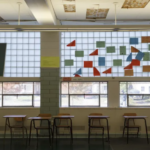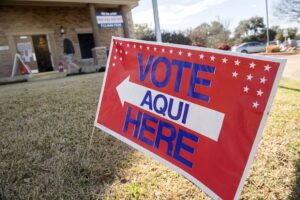Before the term “school choice” even entered the education reform glossary, families who had the means exercised school choice in one distinct way: they moved.
Families moved to more affluent school districts and, in doing so, fed a market-driven segregation cycle, one of the most intractable sources of inequity in the U.S. Even after 1954, when Brown v. Board of Education made mandated segregation illegal, the “will of the people” allowed it to continue in practice, says Bekisizwe Ndimande, a University of Texas at San Antonio professor who researches segregated school systems.
Since Brown, parents of students in white schools have derailed local, state, and national desegregation initiatives. Parents show up to fight multi-family developments in affluent districts. Parents fight efforts to create equitable attendance zones. If all else fails, they move to a more homogenous part of town where the schools will “naturally” be more homogenous.
In San Antonio, current market forces send wealthier families sprawling farther and farther afield into suburbs served by North East ISD, Northside ISD and Schertz-Cibolo-Universal City ISD, or closer into Alamo Heights ISD, which serves the eponymous city-within-a-city. Their tax dollars and high test scores go with them. As a result, schools built to accommodate middle class sprawl — and legacy school districts nestled within high-income communities — become known as the “good schools” that home buyers want. Home prices increase with demand. The cycle of segregation continues. It’s gone on for so long now that it appears natural.
Most experts agree that desegregation improves education outcomes for poor children, a disproportionate number of whom are also Hispanic or black. However, it’s a losing battle to ask middle-class parents — those who can choose where to send their children to school — to move their kids to schools they see as “bad.”
“At the end of the day, it would be very dumb for a parent to take their kid out of a good school,” Ndimande said.
San Antonio ISD is taking a different approach to desegregation. Instead of trying to regulate the existing public school market, the district’s chief innovation officer, Mohammed Choudhury, is trying to disrupt it. To do so he must challenge the basic assumptions of what makes a “good school” and who should get to go there. His goal: take a system of choice that reinforces privilege and use it to level one of the nation’s most unequal playing fields.
What is a ‘good school’?
One of the first questions and criteria a home buyer presents — whether its for their kids or to protect the value of their investment — is, “What are the schools like?”
To answer, agents can visit a host of websites that rank schools (i.e. GreatSchools.org and Niche.com) with star-ratings, A-F letter grades, or some other simplistic scale, real estate agent Lynn Knapik said. For the most part, she said, “realtors are just going by what they think they know.”
Whether realtors check ranking websites or rely on a school’s reputation may not make much difference. The website scores correlate strongly with the realtor’s intuition, because both are tied to income. In fact, show Northside ISD superintendent Brian Woods the home prices in a school’s attendance zone, and he can probably tell you how the school ranks on any given scale. That’s because almost all scales rely heavily on standardized test scores, and the best way to predict a school’s test scores, Woods says, is to look at the income of the families it serves.
Once they are perceived as “low-performing,” schools lose students, which further slashes their funding, which then makes it harder to add student support services and keep high quality teachers in classrooms. Some eventually close. In 2015 and 2016, SAISD closed a total of five schools because of declining enrollment.
Proponents of high stakes testing see it as necessary accountability — universal standards all schools must meet or exceed. However, given the racial disparities on standardized test scores in the 1990s, local attorney Al Kauffman was convinced that standardized testing had a negative impact on Latino and black students. Working with the Mexican American Legal Defence and Education Fund (MALDEF), he sued the state of Texas in 1999 over these disparities.
“Our argument was that TAAS (Texas’ original standardized testing system adopted under Gov. George W. Bush) discriminated against Latinos and African Americans,” Kauffman told Folo Media.
An analysis of the exam’s structure demonstrated how testing outcomes became self-perpetuating. In the design process, part of what determined a good test question was if it mirrored the results of previous tests — including the performance gaps. Verbal construction of word problems worked against English language learners. Test questions themselves were often complex, and while a black or Hispanic student might have known the content being referenced, the syntax and sentence structure favored their verbally advantaged peers.
A federal court ruled against Kauffman and MALDEF. Gov. George W. Bush became President George W. Bush, and took standardized testing national with No Child Left Behind.
Within schools, standardized test scores sorted students into advanced, remedial and honors classes. Racial and income makeup of the classes reflected the gaps on the test. Within neighborhoods, test scores essentially became a marketing tool, justifying the perception that the schools in affluent neighborhoods were simply better. “People who have the ways, means and choice, don’t want to live in a district with low test scores,” Kauffman said.
Changing school rankings by asking new questions
Stanford professor Sean Reardon recently made the case for using a different method to determine the efficacy of education: year-to-year growth of individual students.
“There are many relatively high-poverty school districts where students appear to be learning at a faster rate than kids in other, less poor districts,” Reardon told the Stanford News. He claims that this debunks the assumption that poorer schools are not as good at educating students as wealthier schools. “It’s true that there’s a lot of inequality among students when they start school. But these data suggest that at least in some systems, schools are equalizing forces — that it’s possible for schools in disadvantaged communities to be forces for equity.”
Unlike Chicago, where high poverty schools are advancing students at impressive rates, San Antonio’s poorer schools still don’t grow individual students as fast as affluent schools, according to Reardon’s growth index. The more affluent schools still fare better. However, the growth-rate gap between poor and rich districts is not as stark as the gap between their test scores in a single year.
In 2015, the Texas Education Agency announced that it would begin using a new A-F scoring system that includes a heavier emphasis on student growth and more consideration for how income affects test scores. Traditionally high-performing districts, including Northside ISD, North East ISD and Alamo Heights ISD, fought the new system, which would score some of their schools lower than the previous ranking systems.
“North East ISD is taking the letter ratings with the grain of salt they deserve,” NEISD superintendent Brian Gottardy said in a letter to parents after a January 2017 preview of the A-F system revealed some lower scores for the district.
The first set of official A-F rankings is due to come out in August 2018.
San Antonio ISD supported the new A-F system because of its emphasis on growth. It asks the important question, SAISD chief innovation officer Mohammed Choudhury said: “Are you growing the kids you get?”
It’s also one of the keys to Choudhury’s ultimate goal to desegregate SAISD schools.
Currently, SAISD is 90 percent Hispanic, seven percent black, and two percent white. More than 90 percent of its students meet the criteria for free and reduced lunch, a proxy for economic disadvantage. The school serves some of the poorest ZIP codes in the nation. With numbers likes these, it’s not surprising that 19 out of 90 SAISD schools failed to meet state standards. Twelve other San Antonio area schools also failed to meet state standards.
SAISD expects to see strong growth numbers in the coming years, as it floods the district with highly-paid master teachers (teachers with a track record of high outcomes, especially with low income students), innovative curriculums, and grassroots efforts to redesign schools based on community priorities.
As growth-driven ratings go up, Choudhury says, proving that schools are providing a quality education, he expects more middle class families that are moving into the district’s gentrifying neighborhoods like Dignowity Hill, Beacon Hill, Alta Vista, and Monticello Park, to enroll in SAISD schools. These families might have previously opted for charter schools like Great Hearts, or private schools.
Meanwhile, the district is creating specialized schools that allow students to enroll from anywhere in the county. SAISD’s Advanced Learning Academy (downtown), Travis Early College High School (Tobin Hill), Young Women’s Leadership Academy (YWLA; Monticello Park), and CAST Tech (downtown) are already seeing higher middle class demand than the traditional schools around them. YWLA and Travis have been designated National Blue Ribbon Schools. YWLA has become a regular among the Washington Post’s Most Challenging Schools in America. These are the “gold stars” that, along with novel curriculum, draw families from diverse income brackets and neighborhoods who want an alternative to the traditional school model, Choudhury said.
The article was published at Fighting the urge to segregate San Antonio’s schools.











More Stories
More West Virginia schools will participate in opioid abuse prevention program
Pennsylvania is increasingly underfunding special education, report finds
Memphis’ Kingsbury High School community steps up call for changes